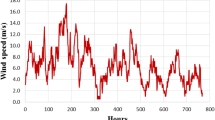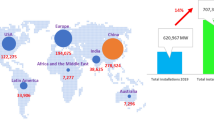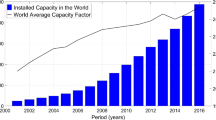Abstract
This paper introduces a novel methodology for determining wind turbines' optimal site matching. Our framework's key component is establishing four new probabilistic models to model wind turbines' capacity factors. First, we used the sum square of errors (SSE) and the determination coefficient (R2) to assess the accuracy of the proposed models. The developed models were then generalized to estimate wind farm capacity factors. After that, the proposed methodology's validity is tested by applying it to a known wind data site. We modeled the available wind data using Weibull distribution. Five different methods were used to determine Weibull parameters. The equivalent energy method combined with the invasive weed optimization algorithm yields the optimal values for these parameters. Finally, under the support of the presented models, the novel methodology is applied to a pool of 24 commercial turbines to choose the optimal ones. A comparison is made between the obtained capacity factor curves using the suggested models and other previous models for the selected wind turbines. When the presented models are utilized, the capacity factor of commercial wind turbines with non-ideal electrical power curves is more precisely predicted.











Similar content being viewed by others
Abbreviations
- PDF:
-
Probability density function
- CDF:
-
Cumulative density function
- SDM:
-
Standard deviation method
- MOM:
-
Method of moment
- EPM:
-
Energy pattern method
- LSM:
-
Least square method
- EEM:
-
Equivalent energy method
- IWO:
-
Invasive weed optimization
- RMSE:
-
Root mean square of errors
- SSE:
-
Sum square of errors
- f(v) :
-
Weibull probability density function
- F(v) :
-
Weibull cumulative density function
- k :
-
Weibull shape factor
- c :
-
Weibull scale factor (m/s)
- v, v avg :
-
Wind speed, and average wind speed, respectively, (m/s)
- v i :
-
The measured wind speed value for the ith data point (m/s)
- σ :
-
Wind speed standard deviation
- n :
-
Sample size
- \(\widehat{{m}_{n}}\) :
-
The nth origin moment
- E pf :
-
Energy pattern factor
- F(v i ) :
-
Weibull cumulative density function value for measured wind speed vi
- Q(v) :
-
Probability of wind speed occurrences greater than a specific value v
- P(V) :
-
Probability of having wind speed V within a specified interval (vi-1,vi)
- ε :
-
Stochastic error term
- P v :
-
Probability density function considering stochastic error
- P vi :
-
Probability of having wind speeds for the ith bin of wind speed histogram
- l :
-
Total number of histogram bins of wind speed
- iter, iter max :
-
Iteration number, and maximum number of iterations, respectively
- σ initial , σ final :
-
Iteration initial and final standard deviation, respectively
- o :
-
Nonlinear modulation index
- σ iter :
-
Iteration standard deviation
- C.f. :
-
Wind turbine capacity factor
- u(v) :
-
The proper probability density function describing wind data
- P f (v) :
-
Wind turbine generated electrical power at wind speed v (MW)
- P rated :
-
Rated wind turbine power (MW)
- v in , v r , v o :
-
Wind turbine cut-in speed, rated speed, and cut-out speed, respectively, (m/s)
- c s, k s :
-
Site scale and shape factors, respectively
- c t , k t :
-
Wind turbine scale and shape factors, respectively
- a 0 , a 1 , a 2 :
-
Fitting models first, second, and third term coefficients
- R 2 :
-
Determination coefficient
- c R :
-
The ratio between site and wind turbine scale factors
- k R :
-
The ratio between site and wind turbine shape factors
- ∆c s :
-
Rate of scale factor (m/s)
- ∆k s :
-
Rate of shape factor
- ∆c R :
-
Relative rate of scale factor
- ∆k R :
-
Relative rate of shape factor
- h, h i :
-
Hub-height and initial hub-height, respectively (m)
- c i , k i :
-
Site wind speed scale and shape factors, respectively, at height hi
- N :
-
Number of interconnected turbines at the site
- k ti , c ti :
-
Shape and scale factors of wind turbine number i, respectively
- zi :
-
Wake effect of turbine number i
- P i-rated :
-
Rated power of wind turbine number i (MW)
- c ti-e :
-
Effective scaling factor
References
Global Wind Energy Council (GWEC).: Global wind report 2019 [Online]. https://gwec.net/global-wind-report-2019. Accessed 10 June 2020
Khaloie, H., Mollahassani-Pour, M., Moghaddam, A.A.: Optimal behavior of a hybrid power producer in day-ahead and intraday markets: a bi-objective CVaR-based approach. IEEE Trans. Sustain. Energy 12(2), 931–943 (2021). https://doi.org/10.1109/TSTE.2020.3026066
Khaloie, H., Moghaddam, A.A., Hatziargyriou, N., Contreras, J.: Risk-constrained self-scheduling of a hybrid power plant considering interval-based intraday demand response exchange market prices. J. Clean. Prod. 282, 125344 (2021). https://doi.org/10.1016/j.jclepro.2020.125344
Bidaoui, H., El Abbassi, I., El Bouardi, A., Darcherif, A.: Wind speed data analysis using Weibull and Rayleigh distribution functions, case study: five cities Northern Morocco. Proc. Manuf. 32, 786–793 (2019). https://doi.org/10.1016/j.promfg.2019.02.286
Mazzeo, D., Oliveti, G., Labonia, E.: Estimation of wind speed probability density function using a mixture of two truncated normal distributions. Renew. Energy 115, 1260–1280 (2018). https://doi.org/10.1016/j.renene.2017.09.043
Khalfallah, M.G., Koliub, A.M.: Suggestions for improving wind turbines power curves. Desalination 209(1–3), 221–229 (2007). https://doi.org/10.1016/j.desal.2007.04.031
Albadi, M.H., El-Saadany, E.F.: Wind turbines capacity factor modeling—a novel approach. IEEE Trans. Power Syst. 24(3), 1637–1638 (2009). https://doi.org/10.1109/TPWRS.2009.2023274
Jangamshetti, S.H., Rau, V.G.: Site matching of wind turbine generators: a case study. IEEE Trans. Energy Convers. 14, 1537–1543 (1999). https://doi.org/10.1109/60.815102
Diyoke, C.: A new approximate capacity factor method for matching wind turbines to a site: case study of Humber region, UK. Int J Energy Environ Eng 10, 451–462 (2019). https://doi.org/10.1007/s40095-019-00320-5
Lydia, M., Selvakumar, A.I., Kumar, S.S., Kumar, G.E.P.: Advanced algorithms for wind turbine power curve modelling. IEEE Trans. Sustain. Energy 4(3), 827–835 (2013). https://doi.org/10.1109/TSTE.2013.2247641
Ouarda, T.B.M.J., Charron, C.: On the mixture of wind speed distribution in a Nordic region. Energy Convers. Manage. 174, 33–44 (2018). https://doi.org/10.1016/j.enconman.2018.08.007
Mazzeo, D., Oliveti, G., Marsico, A.: A correction to the unimodal and bimodal truncated normal distributions for a more accurate representation of extreme and calm wind speeds. Int. J. Energy Res. 43, 7908–7941 (2019). https://doi.org/10.1002/er.4735
Jung, C., Schindler, D.: Sensitivity analysis of the system of wind speed distributions. Energy Convers. Manag. 177, 376–384 (2018). https://doi.org/10.1016/j.enconman.2018.09.078
Ali, S., Lee, S.-M., Jang, C.-M.: Statistical analysis of wind characteristics using Weibull and Rayleigh distributions in Deokjeok-do Island–Incheon South Korea. Renew. Energy 123, 652–663 (2018). https://doi.org/10.1016/j.renene.2018.02.087
Aukitino, T., Khan, M.G.M., Ahmed, M.R.: Wind energy resource assessment for Kiribati with a comparison of different methods of determining Weibull parameters. Energy Convers. Manag. 151, 641–660 (2017). https://doi.org/10.1016/j.enconman.2017.09.027
Bokde, N., Feijóo, A., Villanueva, D.: Wind turbine power curves based on the weibull cumulative distribution function. Appl. Sci. 8, 1757 (2018). https://doi.org/10.3390/app8101757
Omar, O.A.M., Ahmed, H.M., Elbarkouky, R.A.: Commercial wind turbines modeling using single and composite cumulative probability density functions. Int. J. Electr. Comput. Eng. 11(1), 47–56 (2021). https://doi.org/10.11591/ijece.v11i1.pp47-56
Carrillo, C., Montaño, A.F.O., Cidrás, J., Díaz-Dorado, E.D.: Review of power curve modelling for wind turbines. Renew. Sustain. Energy Rev. 21, 572–581 (2013). https://doi.org/10.1016/j.rser.2013.01.012
Staffell, I., Pfenninger, S.: Using bias-corrected reanalysis to simulate current and future wind power output. Energy 114, 1224–1239 (2016). https://doi.org/10.1016/j.energy.2016.08.068
Rienecker, M.M., Suarez, M.J., Gelaro, R., Todling, R., Bacmeister, J., Liu, E., et al.: MERRA: NASA’s modern-era retrospective analysis for research and applications. J. Clim. 24(14), 3624–3648 (2011). https://doi.org/10.1175/JCLI-D-11-00015.1
Molod, A., Takacs, L., Suarez, M., Bacmeister, J.: Development of the GEOS-5 atmospheric general circulation model: evolution from MERRA to MERRA2. Geosci. Model Dev. 8(5), 1339–1356 (2015). https://doi.org/10.5194/gmd-8-1339-2015
Lileo, S., Petrik, O.: Investigation on the use of NCEP/NCAR, MERRA and NCEP/ CFSR reanalysis data in wind resource analysis. In Wind Energy Conf. Exhib (EWEC), pp. 181–185 (2011)
Gualtieri, G.: Improving investigation of wind turbine optimal site matching through the self-organizing maps. Energy Convers. Manag. 143, 295–311 (2017). https://doi.org/10.1016/j.enconman.2017.04.017
El-Shimy, M.: Wind energy conversion systems: reliability prospective. Encycl. Energy Eng. Technol. 2, 2184–2206 (2014)
Aghbalou, N., Charki, A., Elazzouzi, S.R., Reklaoui, K.: A probabilistic assessment approach for wind turbine-site matching. Int. J. Electr. Power Energy Syst. 103, 497–510 (2018). https://doi.org/10.1016/j.ijepes.2018.06.018
Sedaghat, A., Alkhatib, F., Eilaghi, A., Sabati, M., Borvayeh, L., Mostafaeipour, A.: A new strategy for wind turbine selection using optimization based on rated wind speed. Energy Proc. 160, 582–589 (2019). https://doi.org/10.1016/j.egypro.2019.02.209
Sedaghat, A., Mostafaeipour, A., Rezaei, M., Jahangiri, M., Mehrabi, A.: A new semi-empirical wind turbine capacity factor for maximizing annual electricity and hydrogen production. Int. J. Hydrogen Energy 45(32), 15888–15903 (2020). https://doi.org/10.1016/j.ijhydene.2020.04.028
Azad, A.K., Rasul, M.G., Yusaf, T.: Statistical diagnosis of the best Weibull methods for wind power assessment for agricultural applications. Energies 7, 3056–3085 (2014). https://doi.org/10.3390/en7053056
Saeed, M.K., Salam, A., Rehman, A.U., Saeed, M.A.: Comparison of six different methods of Weibull distribution for wind power assessment: a case study for a site in the Northern region of Pakistan. Sustain. Energy Technol. Assess. 36, 100541 (2019)
Mehrabian, A.R., Lucas, C.: A novel numerical optimization algorithm inspired from weed colonization. Ecol. Inform. 1(4), 355–366 (2006). https://doi.org/10.1016/j.ecoinf.2006.07.003
Albadi, M.H., El-Saadany, E.F.: Optimum turbine-site matching. Energy 35, 3593–3602 (2010). https://doi.org/10.1016/j.energy.2010.04.049
Johnson, G.L.: Wind energy systems. Prentice Hall, New York (2001)
Tao, S., Xu, Q., Feijóo, A., Kuenzel, S., Bokde, N.: Integrated wind farm power curve and power curve distribution function considering the wake effect and terrain gradient. Energies 12(13), 2482 (2019). https://doi.org/10.3390/en12132482
Dong, X., Li, J., Gao, D., Zheng, K.: Wind speed modeling for cascade clusters of wind turbines part 1: the cascade clusters of wind turbines. Energy 205, 118097 (2020). https://doi.org/10.1016/j.energy.2020.118097
Mortensen, N.G., Hansen, J.C., Badger, J., Jørgensen, B.H., Hasager, C.B., Paulsen, U.S., Hansen, O.F., Enevoldsen, K., Youssef, L.G., Said, U.S., Moussa, A.A.E.-S., Mahmoud, M.A., Yousef, A.E.S., Awad, A.M., Ahmed, M.A.-E.R., Sayed, M.A.M., Korany, M.H., Tarad, M.A.-E.B.: Wind atlas for Egypt: measurements, micro-, and mesoscale modeling. Eur. Wind Energy Conf. Exhib. (EWEC) 1, 136–145 (2006)
Author information
Authors and Affiliations
Corresponding author
Additional information
Publisher's Note
Springer Nature remains neutral with regard to jurisdictional claims in published maps and institutional affiliations.
Appendices
Appendix A: Wind Atlas of Egypt at specified sites [35]
Region | Site ID | Site name | Site data | |||||
|---|---|---|---|---|---|---|---|---|
Lat. \(({\mathrm{N}}^{\mathrm{o}})\) | Long. \(({\mathrm{E}}^{\mathrm{o}})\) | \({h}_{i}\) (m) | \({c}_{i}\) (m/s) | \({k}_{i}\) | Avg. (m/s) | |||
North Coast | 1 | Sidi Barani (62,301) | 31.47 | 25.87 | 24.5 | 7 | 2.16 | 6.2 |
2 | El-Mathany | 31.35 | 26.88 | 24.5 | 6.4 | 2.33 | 5.7 | |
3 | Ras El-Hekma | 31.25 | 27.86 | 24.5 | 7.2 | 2.23 | 6.4 | |
4 | El-Galaa | 31.08 | 26.7 | 24.5 | 6.7 | 2.41 | 5.9 | |
5 | Alexandria (62,318) | 31.2 | 29.92 | 10 | 5.2 | 2.42 | 4.6 | |
6 | Port Said | 31.27 | 32.3 | 24.5 | 5.3 | 2.32 | 4.7 | |
7 | El- Arish (62,337) | 31.13 | 33.8 | 8.5 | 3 | 1.44 | 2.8 | |
Gulf of Aqaba | 8 | Nuweiba | 28.97 | 34.65 | 24.5 | 6.2 | 2.58 | 5.6 |
9 | Nabq | 28.04 | 34.43 | 24.5 | 7.7 | 2.04 | 6.8 | |
Gulf of Suez | 10 | Katamaya | 29.92 | 31.82 | 24.5 | 6 | 2.66 | 5.4 |
11 | El-Suez (62450) | 29.97 | 32.55 | 10 | 6.2 | 3.17 | 5.5 | |
12 | Ras Sedr | 29.6 | 32.67 | 24.5 | 8.5 | 3.06 | 7.6 | |
13 | Abu Darag NW | 29.47 | 32.45 | 47.5 | 9.6 | 3.34 | 8.6 | |
14 | Abu Darag | 29.47 | 32.45 | 24.5 | 10.1 | 3.5 | 9.1 | |
15 | Zafarana M7 | 29.22 | 30.82 | 47.5 | 11.1 | 3.57 | 10 | |
16 | Zafarana | 29.12 | 32.66 | 24.5 | 10.2 | 3.19 | 9.1 | |
17 | Saint Paul | 28.78 | 32.78 | 24.5 | 9.4 | 3.25 | 8.5 | |
18 | Ras Ghareb | 28.35 | 33.08 | 24.5 | 11 | 3.4 | 9.9 | |
19 | Gulf of El-Zayt NW | 28.00 | 33.30 | 24.5 | 11.8 | 3.7 | 10.7 | |
20 | Gulf of El-Zayt | 27.77 | 33.61 | 24.5 | 11.5 | 3.29 | 10.3 | |
Red Sea | 21 | Hurghada WETC | 27.26 | 33.81 | 24.5 | 7.6 | 2.23 | 6.7 |
22 | Hurghada (62,463) | 27.18 | 33.8 | 10 | 7.6 | 2.66 | 6.7 | |
23 | Kossier (62465) | 26.43 | 34.07 | 10 | 5.1 | 2.03 | 4.6 | |
24 | Kossier | 26.11 | 34.27 | 24.5 | 6.5 | 2.32 | 5.8 | |
Western Desert | 25 | Farafra (62423) | 27.06 | 27.97 | 10 | 3.9 | 1.79 | 3.5 |
26 | Kharga | 25.44 | 30.56 | 24.5 | 7.4 | 2.57 | 6.6 | |
27 | Dakhla South | 23.99 | 29.19 | 24.5 | 7.3 | 3.31 | 6.6 | |
28 | Shark El—Ouinat | 22.72 | 28.11 | 24.5 | 7.2 | 3.29 | 6.5 | |
29 | Asswan (62412) | 24.09 | 32.9 | 10 | 5.4 | 2.61 | 4.8 | |
30 | Abu Simbel | 24.08 | 32.9 | 24.5 | 6.4 | 2.76 | 5.4 | |
Appendix B: Commercial wind turbines data [17]
Turbine ID | Turbine name | Turbine data | |||||
|---|---|---|---|---|---|---|---|
Rating (KW) | \(v_{in}\)(m/s) | \(v_{r}\)(m/s) | \(v_{out}\)(m/s) | \(c_{t}\) (m/s) | \(k_{t}\) | ||
1 | Vestas (V80) | 2000 | 4.0 | 16.0 | 25.0 | 9.6420951 | 4.5786415 |
2 | Siemens (S82) | 2300 | 4.0 | 13.5 | 25.0 | 10 | 4.1929594 |
3 | Repower (RE82) | 2050 | 3.5 | 14.5 | 25.0 | 9.4212791 | 4.557548 |
4 | Nordex (N90) | 2300 | 3.0 | 12.0 | 25.0 | 9.9995814 | 4.1613744 |
5 | Siemens (S107) | 3600 | 3.0 | 13.0 | 25.0 | 9.6739173 | 4.6331647 |
6 | Vestas (V164) | 6995 | 4.0 | 13.0 | 25.0 | 9.4674353 | 4.3835995 |
7 | An-Bonus (1000/54) | 1000 | 3.0 | 15.0 | 25.0 | 10.1682039 | 3.51399081 |
8 | Enercon (E53) | 810 | 3.0 | 12.0 | 34.0 | 9.11191916 | 3.50978311 |
9 | Leitwind (LTW77–1000) | 1000 | 3.0 | 11.0 | 25.0 | 7.91437529 | 3.75144762 |
10 | Leitwind (LTW80–850) | 850 | 3.0 | 10.0 | 25.0 | 7.21305636 | 5.08338348 |
11 | Leitwind (LTW90–1000) | 1000 | 3.0 | 9 | 25.0 | 6.86532481 | 4.77729061 |
12 | Vestas (V47) | 660 | 4.0 | 15.0 | 25.0 | 9.66602728 | 4.04811810 |
13 | Wind Tech Windane (DWT34) | 400 | 5.5 | 14 | 25.0 | 10.9005567 | 5.07686715 |
14 | Enercon (E40/5.4) | 500 | 2.5 | 12.0 | 25.0 | 9.61051239 | 5.08680599 |
15 | Turbowinds (T400–34) | 400 | 3.0 | 14.0 | 25.0 | 9.96184430 | 5.44584277 |
16 | Vestas (V39) | 500 | 4.0 | 15.0 | 25.0 | 10.1185051 | 3.95460524 |
17 | Wespa (500/47) | 500 | 4.0 | 14.5 | 25.0 | 8.47204202 | 5.30386838 |
18 | Windflow (45–500) | 500 | 4.5 | 11.5 | 25.0 | 9.44318401 | 3.75527729 |
19 | Leitwind (LTW42–250) | 250 | 3.0 | 9.0 | 25.0 | 7.3715829 | 4.0697689 |
20 | Windmaster (Hmzwm 300/25) | 300 | 5.0 | 15.0 | 25.0 | 11.9992984 | 3.56446705 |
21 | Vergnet (C275/30) | 275 | 3.5 | 12.0 | 25.0 | 9.44229627 | 4.73408344 |
22 | Vestas (V27) | 225 | 3.0 | 15.0 | 25.0 | 9.71250815 | 3.93238423 |
23 | Wespa (200/31) | 200 | 4.0 | 13.5 | 25.0 | 9.4369866 | 5.2200093 |
24 | Norwin (29-STALL-225) | 225 | 4.0 | 14.0 | 25.0 | 11.004852 | 4.0108782 |
Rights and permissions
About this article
Cite this article
Omar, O.A.M., Ahmed, H.M. & Elbarkouky, R.A. Wind turbines new criteria optimal site matching under new capacity factor probabilistic approaches. Energy Syst 14, 419–444 (2023). https://doi.org/10.1007/s12667-021-00463-7
Received:
Accepted:
Published:
Issue Date:
DOI: https://doi.org/10.1007/s12667-021-00463-7




